Automotive Warranties:
In terms of warranty accruals, vehicle makers are setting aside less funds in 2008 than they did a year ago, while their suppliers are setting aside more. But before one concludes that supplier recovery efforts are the primary reason, let's allow some time for recent litigation and asset sales to be fully reflected in the numbers.
Despite all the recent doom-and-gloom headlines about the future of the U.S.-based automakers and their suppliers, there doesn't seem to be much to get concerned about in terms of their warranty costs.
Compared to a year ago, product sales are up a bit, and claims are up a bit more, which bumped the claims rate up fractionally from a weighted average of 1.65% in the first quarter of 2007 to 1.69% this year. But accruals are actually down, and the accrual rate for all automotive manufacturers and suppliers taken together has slipped from 1.63% in 2007 to 1.54% in 2008.
That's how much things have changed in the past year: we had to go to hundredths of a percentage point to measure the change. While that doesn't in itself improve the prospects of any of the big names avoiding bankruptcy, contrast these relatively minor changes with the dire situation of the homebuilding industry that was profiled in the June 20 newsletter.
In that rapidly deteriorating sector, we found homebuilders cutting back on warranty accruals to save cash as sales revenue plummets. In the auto business, the only clear case of cutting we found has much to do with a nasty lawsuit in which the eventual settlement of the case is probably going to take the place of warranty claims payments. And while the homebuilders rise and fall on purely domestic U.S. market conditions, the U.S.-based automakers have export markets that are still expanding.
Automotive OEMs vs. Suppliers
In Figure 1 below, the warranty accruals of some 109 current and 27 former automotive companies based in the U.S. are counted, taken together and split into either suppliers or OEMs. For companies that do both, we put the entire company into just one category or the other, based on whichever accounted for the majority of sales. And for companies that are in both the automotive business as well as other industries, we counted all their reported warranty expenses as automotive, even if some came from telecom, appliances, aerospace, or other industries.
Figure 1
Automotive Manufacturers:
Average Warranty Accrual Rates, 2003-2008
(as a percentage of product revenue)

So far we've counted a total of $3.6 billion in warranty claims payments reported during the first quarter of 2008 by U.S.-based automotive OEMs and their suppliers, up 4.0% from the first quarter of 2007 but down 4.6% from the fourth quarter of 2007. And we've counted $3.4 billion in automotive warranty accruals, down by 5% from a year ago and down 17% from the record-breaking fourth quarter of 2007.
Persistent Gap
The gap between OEMs and their suppliers continues into 2008. In fact, the gap between claims rates for OEMs and suppliers is back to 1.7% -- its long-term average -- after having narrowed slightly in 2007. We'd once thought that was the beginning of a concerted effort by OEMs to push more of their warranty costs back onto their suppliers, but alas, that trend seems to have fizzled out. Or has it?
Figure 1 tracks accrual rates, and those rates have narrowed considerably more than claims. The gap between OEMs and suppliers in terms of accrual rates is now down to 1.3%, from 1.6% a year ago and 1.8% three years ago. So perhaps the trend is still in play, at least in terms of how the OEMs and suppliers are planning for the future? In other words, perhaps they are signaling their belief in the trend towards increased supplier recovery and are adjusting their accrual rates accordingly?
The average accrual rate for all automotive manufacturers (OEM and supplier) illustrated by the middle line in Figure 1 has also taken a big half-point drop in the first quarter of 2008, compared to the end of 2007. Only a handful of medium-sized players haven't filed their 2008 financial reports with the U.S. Securities and Exchange Commission on time, so this drop could not have been caused by the absence of any major warranty providers.
Instead, it looks like it's an annual phenomenon, caused perhaps by the pressure to overpay expenses at year's end, and underpay in the next quarter, leading to a drop in first quarter accrual rates. It's happened in five of the six years charted in Figure 1, with 2004 being the sole exception.
There doesn't seem to be much seasonality in the segments charted in Figures 2 and 3, but remember these are accruals, so they really should be less variable than claims. Accruals are usually made at the time of sale per unit of sale, based on predictions of future warranty cost per unit of sale. So accruals should rise and fall in lock step with sales, and the ratio between the two should remain the same.
Steady Market Segments
There's not much surprise in the five segments charted in Figure 2. Three segments are more or less steady while two are showing a more or less seasonal pattern over the past five years. For recreational vehicles in particular, warranty accrual rates seem to drop in the summer when sales are at their peak. The long-term average accrual rate for RVs is 2.3%, a notch up from the 2.2% rate seen for farm and lawn equipment and just below the 2.5% average seen for all OEMs.
Figure 2
Automotive Manufacturers:
Average Warranty Accrual Rates, 2003-2008
(as a percentage of product revenue)

The long-term average accrual rate for smaller vehicles such as motorcycles, golf carts, and forklifts is closer to 1.4%, while parts suppliers are at 0.8%. But it's not a case of the bigger the vehicle, the higher the warranty cost. Passenger car OEMs are at 2.7%; bus manufacturers are at 2.4%, and heavy truck manufacturers are at 1.7%.
The big news in Figures 2 and 3 is the return of some major players that had been in bankruptcy proceedings or were embroiled in warranty-related litigation. Most notably, Navistar is back after a three-year absence, which is reflected in the truck, bus, and engine/drivetrain segments below.
Welcome Back, Navistar
In our last attempt to segment the U.S. automotive market, published on May 31, 2007, the truck and bus segments were marked as unreliable, because of the absence of data from Navistar and some other major companies. Well, now they're back, and the calculations of warranty accrual rates for those segments are once again believable and complete.
The bumps in the late 2004 accrual rates for trucks and buses are -- you guessed it -- related to Navistar. Just before the company began missing filing deadlines at the SEC, it dropped an unusually large $299 million accrual into its warranty reserve. That spiked its accrual rate to 4.7% at the end of 2004. Because Navistar is such a major part of the truck and bus business, those segments spiked as well.
Figure 3
Automotive Manufacturers:
Average Warranty Accrual Rates, 2003-2008
(as a percentage of product revenue)

In Figure 3, perhaps the biggest surprise is the declining accrual rate of General Motors and Ford combined. After peaking at 3.1% in 2005, their combined accrual rates fell to around 2.6% in 2006 and 2007, before slipping to just 2.3% in the first quarter of 2008. Admittedly, this may have lots to do with plans for the then-impending sale of Land Rover and Jaguar to Tata Motors, but accrual rates are also down at GM where no major asset sale is planned.
And remember, accruals should always be proportional to sales, so unlike the claims rate, the accrual rate should not be affected by sales declines. It should only be changed to reflect changes in product quality or warranty duration, and therefore changes in the expected future cost of warranties issued at the time of sale.
As mentioned, new warranty data is also available for Navistar, which is now once again filing its financial reports on time with the SEC. These quarterly and annual reports have filled in the blanks for 2006 and 2007, and they show a divergence last year between claims paid and accruals made (see Figure 4).
Figure 4
Navistar International Corp.
Warranty Claims & Accrual Rates, 2003-2008
(in $ Mil & percentage of product sales)
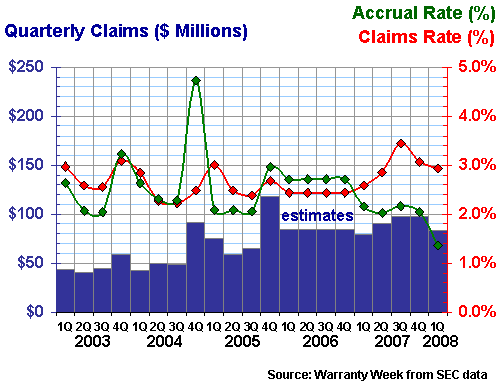
Claims data for 2006 had to be estimated from the annual report, because Navistar didn't make quarterly filings that year. So we've estimated a 2.4% claims rate and a 2.7% accrual rate for the entire year. And that section of the graph is flat. As the charts shows, claims and accruals were closely tracking each other in 2003-2006, except for that one spike in late 2004. But in 2007, according to new data, the company began putting less funds into the warranty reserve than it was taking out.
Lawsuit-Related Warranty Changes
This tactic is directly related to the Ford lawsuit. Early last year, Navistar and Ford went to court over allegedly high warranty costs associated with one of Navistar's V-8 diesel engines, used in Ford�s diesel-powered super-duty trucks and vans. While the dispute continues, engines sales continue, but warranty accruals don't.
While Ford and Navistar sue and countersue each other, Navistar is not accruing for warranty on the engines it sells to Ford. Instead, while the lawsuit proceeds it is allowing its warranty reserve to shrink in size -- by $100 million in 2007 and by another $69 million so far in 2008. The company still has more than $600 million in the warranty reserve and extended warranty reserve, however, so it is well-cushioned even without the Ford engine accruals. But those funds are for other customers' engines and trucks, not Ford's, so where will the funds come from if the lawsuit settlement includes a warranty claim payment by Navistar to Ford?
Here's Navistar's version of events:
"In January 2007, a complaint was filed against us in Oakland County Circuit Court in Michigan by Ford claiming damages relating to warranty and pricing disputes with respect to certain engines purchased by Ford from us. While Ford�s complaint did not quantify its alleged damages, we estimate that Ford may be seeking in excess of $500 million, and that this amount may increase as we continue to sell engines to Ford at a price that Ford alleges is too high and as Ford pays its customers� warranty claims, which Ford alleges are attributable to us.
"We disagree with Ford�s position and are defending ourselves vigorously in this litigation. We have filed an answer to the complaint denying Ford�s allegations in all material respects. We have also asserted affirmative defenses to Ford�s claims, as well as counterclaims alleging that, among other things, Ford has materially breached contracts between it and us in several different respects. Based on our investigation to date, we believe we have meritorious defenses to this matter.
"There can be no assurance, however, that we will be successful in our defense, and an adverse resolution of the lawsuit could have a material adverse effect on our results of operations, cash flows, or financial condition. In June 2007, we filed a separate lawsuit against Ford in the Circuit Court of Cook County, Illinois, for breach of contract relating to the manufacture of new diesel engines for Ford for use in vehicles including the F-150 pickup truck. In that case we are seeking unspecified damages. In September 2007, the judge dismissed our lawsuit against Ford, directing us to proceed with mediation. In February 2008, we re-filed the lawsuit against Ford because the parties were unable to resolve the dispute through mediation."
While the suit proceeds, Navistar is not making warranty accruals for the diesel engines it sells to Ford. And since it was late with all those SEC filings in 2006 and 2007, it has made that decision retroactively for three years. Navistar states that "due to our disagreement with Ford over our obligation to share warranty costs, we have not recorded any additional amounts in our warranty accrual for engine sales to Ford since July 31, 2005. Amounts previously recorded, prior to July 31, 2005, have not been reversed, even though we believe we may not be legally required to make any payments."
And here's what Ford had to say about the lawsuit and counter-suit:
"In January 2007, we filed suit against the single-source supplier of diesel engines for our F-Series Super Duty and Econoline vehicles. Among other things, we sought reimbursement for warranty and related costs involving prior model-year diesel engines supplied by International Truck and Engine Corporation (a subsidiary of Navistar International Transportation Corporation).
"International countersued, asserting damages in excess of $2 billion and alleging, among other things, that we materially breached provisions of the supply agreement with regard to warranty, pricing, and exclusivity. International also filed its own suit in Cook County, Illinois, alleging breach of our diesel engine pre-development contract.
"We believe that International's claims are without merit, and we intend vigorously to prosecute our claims against International and defend against this countersuit. As part of the pending litigation, the court has issued an order requiring International to ship engines to us, and permitting us to pay a disputed price under protest, while reserving our right to pursue recovery of the disputed amount."
Ford accounted for 54% of the Navistar engine segment's business in the first half of 2008 and 58% in 2007. Even while the lawsuit continues, Ford is still putting the Navistar V-8 diesels into its trucks and vans. And it is still selling them, backed by a Ford warranty. But that sales volume is now slowing, because of the high price of diesel fuel, and the undesirability of large passenger vehicles. Navistar said it "initiated a temporary layoff" at its Indianapolis facility after Ford announced in May that it was scaling back its pick-up and SUV productions levels in response to a drop in demand.
Supplier Warranty Changes
In Figure 5 through 9 we're looking at the warranty records of five of the best-known automotive suppliers, and while the recent trend is up for each, one must keep in mind that they're all coming up from relatively low percentage rates. Delphi, for instance, has seen its claims rate jump from 0.4% to 0.6% and most recently to 0.9%, but it's in an industry segment (automotive suppliers) where 0.7% to 0.8% is typical.
Figure 5
Delphi Corp.
Warranty Claims & Accrual Rates, 2003-2008
(in $ Mil & percentage of product sales)
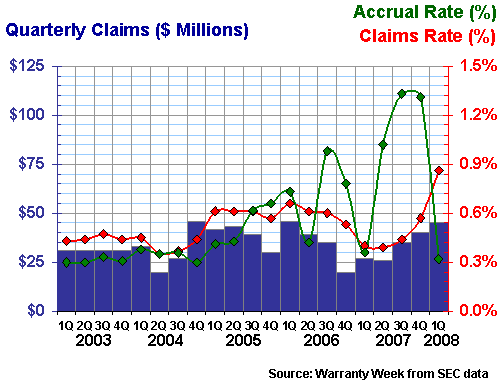
Delphi has now settled court cases related to the alleged misclassification of funds exchanged with former parent General Motors, but its actual warranty accrual rate has now dove back down below 1%, after spending much of 2006 and 2007 above that level. At Visteon, payments to customers such as former parent Ford Motor Co. are once again on the downswing, though accruals continue to rise.
Figure 6
Visteon Corp.
Warranty Claims & Accrual Rates, 2003-2008
(in $ Mil & percentage of product sales)

BorgWarner, meanwhile, seems to have weathered its warranty crisis of 2007 rather gallantly, with both claims and accruals returning to the normal range. First quarter 2008 accruals are back under 0.7% after peaking at just under 2% of revenue a year ago, while claims rates are once again under 0.5% after having peaked at 1.03% of revenue at the end of 2007.
Figure 7
BorgWarner Inc.
Warranty Claims & Accrual Rates, 2003-2008
(in $ Mil & percentage of product sales)
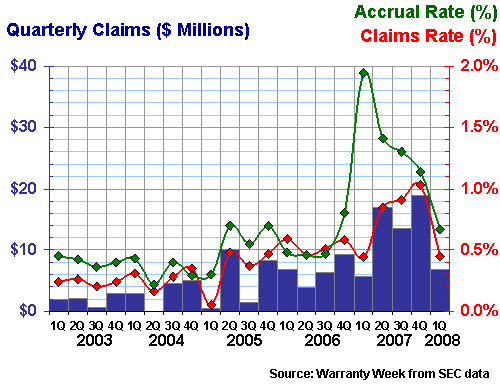
ArvinMeritor is squarely in the drivetrain business, which as a quick glance at Figures 2 and 3 reveals, are subject to more OEM-like warranty costs than most other kinds of automotive suppliers. Still, the company's claims costs seem poised to pierce the 1% of revenue level for the first time since at least 2003, when public reporting of warranty expenses first began. But the company seems to have anticipated this rise by bumping up its accrual rate as high as 1.3% a year ago, when claims costs began their most recent ascent.
Figure 8
ArvinMeritor Inc.
Warranty Claims & Accrual Rates, 2003-2008
(in $ Mil & percentage of product sales)
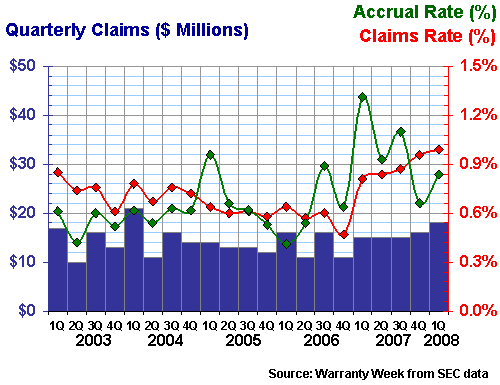
And then finally there's Dana Holding Corp., which like ArvinMeritor is also in the drivetrain business and like Navistar is now back to a filing schedule that meets SEC deadlines. Dana emerged from a two-year-long bankruptcy proceeding in January, and is now back to reporting claims and accrual rates around 0.6% after seeing them peak at around 0.9% about a year ago. However, it has yet to return to the levels seen in 2004 and the first half of 2005, when claims and accrual rates were not only much lower but also less volatile.
Figure 9
Dana Holding Corp.
Warranty Claims & Accrual Rates, 2003-2008
(in $ Mil & percentage of product sales)
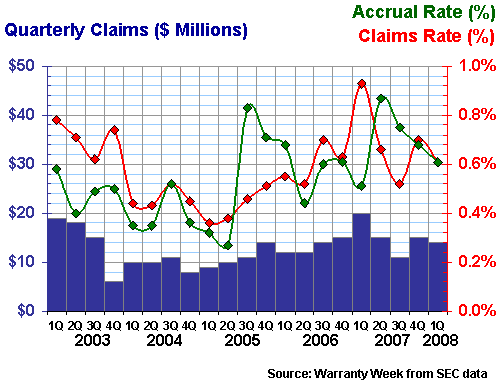
One could combine the lower recent accrual rates seen at GM and Ford with the higher accrual rates seen at some of their key suppliers and suggest that the gap is narrowing thanks to an increasingly successful focus on supplier recovery. And indeed, the data in Figure 1 seems to support that conclusion. However, on the claims side what seemed to be a narrowing trend in 2007 was absent in early 2008.
Time Will Tell
The lesson learned is perhaps to wait for more data. The figures reported in the first quarters of any given year seem to always be the lowest of the year. So let's wait and see what happens in the second and third quarters, in case what we suspect is a trend turns out instead to be just an anomaly. Plus, the outcomes of the Ford-Navistar dispute and the Ford-Tata sale could still swing the numbers significantly.








